11th BK Chapter 2 Practical Problems – Maharashtra Board – Free Resource
Table of Contents
11th BK Chapter 2 Practical Problems
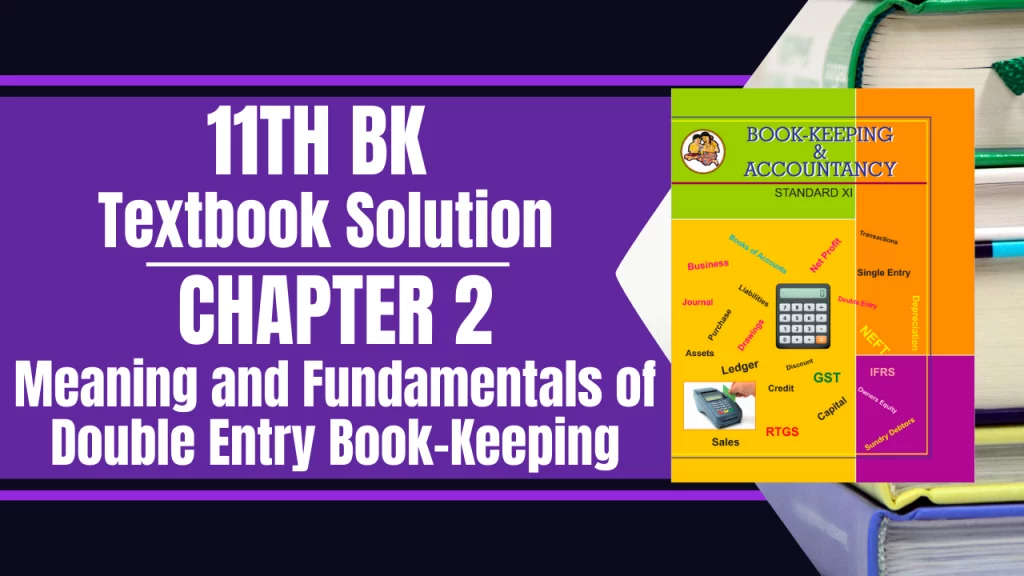
Chapter 2 – Meaning and Fundamentals of Double Entry Book-Keeping
Q.1 Answer in one sentence only
1) What is Double Entry System?
Answer: The double Entry System is the most scientific method of recording all business transactions in the books of accounts. Under this system, double or two fold effects of each transaction is recorded.
2) What is an Account?
Answer: An account is a ledger record in a summarized form of all the transactions that have taken place with the particular person or thing specified.
3) State the meaning of Single Entry System.
Answer: This system of accounting records only Cash books and Personal accounts. It is unscientific method and also known as an incomplete recording system, because it changes with the convenience of business for recording transactions.
4) What is Personal Account?
Answer: This account represents a person and group of persons with whom business deals.
5) State the rule of Nominal Account.
Answer: The account of expenses, losses, income, and gains are called as Nominal accounts e.g. Wages A/c, Stationery A/c, Salary A/c, etc.
6) Give two examples of intangible assets?
Answer: Goodwill A/c, Patents A/c, Trademark A/c, Copyright A/c, etc.
7) State the meaning of Real Account.
Answer: This account represents assets and properties owned by the business.
8) Give two examples of income and gains.
Answer: Commission Received A/c, Discount Received A/c, etc.
9) State the rule of Personal Account.
Answer: Debit the receiver, Credit the giver
10) How many methods of recording accounting information are there?
Answer:
1) Indian System
2) English System
A) Single Entry System
B) Double Entry System
Q.2 Write one word/term or phrase which can substitute each of the following statements.
1) Method of Accounting which records both aspects of transaction.
Answer: Double entry system
2) Right-hand side of an account.
Answer: Credit side.
3) Name of the account which is debited when proprietor uses business money for personal use.
Answer: Drawing A/c
4) Accounts of Assets and Properties.
Answer: Real A/c
5) Accounts of Expenses and Losses and Incomes and Gains.
Answer: Nominal A/c
6) Left-hand side of an account.
Answer: Debit side
7) The Assets which cannot be seen, touched or felt.
Answer: Intangible Assets
8) Person who invented the Double Entry System.
Answer: LUCA D. BARGO PACIOLI
9) Incomplete system of recording business transactions.
Answer: Single entry system
10) Scientific system of recording business transactions.
Answer: Double entry system
Q.3 Select the most appropriate alternatives from those given below and rewrite the statements
1) International Accounting day is observed on _____.
a) 10th November
b) 12th November
c) 10th December
d) 15th December
2) Conventional system of accounting is _____.
a) English entry system
b) Double entry system
c) Indian system
d) None of these
3) Every debit has a corresponding _____.
a) Debit
b) Credit
c) Right-hand side
d) None of these
4) Radha`s Account is a type of _____ account.
a) Nominal
b) Personal
c) Real
d) Expenses
5) Machinery Account is _____ account.
a) Nominal
b) Income
c) Personal
d) Real
6) Goodwill is _____ asset.
a) Tangible
b) Current
c) an intangible
d) None of these
7) Prepaid expenses is _____ account.
a) Real
b) Personal
c) Nominal
d) Income
8) Debit the receiver, Credit the _____.
a) Goes out
b) Giver
c) Income and gains
d) Comes in
9) Debit what comes in, Credit what _____.
a) Giver
b) Expenses and losses
c) Goes out
d) Income and gains
10) Debit all _____ and Credit all income and gains.
a) Giver
b) Expenses and losses
c) Goes out
d) None of these
11th BK Chapter 2 Practical Problems
Solution of other subjects
Solution of all Chapters of BK
1 – 2 – 3 – 4 – 5 – 6 – 7 – 8 – 9 – 10
Q.4 State whether the following statements are true or false with reasons
1) Outstanding expense is a nominal account.
Answer: False
Reason: Outstanding expenses are personal accounts. It is a representative personal account. Expenses are payable to some person.
2) Capital account is a real account.
Answer: False
Reason: Capital is a personal account. Amount invested in the business by the proprietor is capital. A proprietor is a natural person.
3) Every debit has equal and corresponding credit.
Answer: False
Reason: Under the Double Entry System, the two-fold effects of each transaction are recorded. Under this system one account is to be debited and another is to be credited with an equal amount.
4) Discount received is a nominal account.
Answer: True
Reason: Discount received in an income for the business. All expenses and income come under the Nominal account.
5) Drawing account is a nominal account.
Answer: False
Reason: The drawing is a Personal account. Drawing means cash on goods withdrawn by the proprietor for personal use. As the proprietor is a Personal account his drawings are also a Personal account.
6) Outstanding salary is a nominal account.
Answer: False
Reason: Outstanding salary is Personal account. Salary is the amount payable to staff. As he is a person, the amount payable to him is a personal account. It is a Representative Personal account.
7) Loan account is a personal account.
Answer: True
Reason: The loan is taken from a person or bank and they are persons either natural or person or artificial persons.
8) Goodwill account is a real account.
Answer: True
Reason: All properties/assets come under real accounts. Goodwill is an intangible asset so goodwill is a Real account.
9) Discount account is a nominal account.
Answer: False
Reason: Trade discount is a noncash transaction it is not recorded in the books of account so it doesn’t fall under any account.
10) Personal transactions of proprietor are recorded in the books of account of business.
Answer: False
Reason: Personal transactions of proprietors are not recorded in the books of account of business. Only business transactions are recorded in the books of account of business as businesses have a separate entity.
11) Motor car account is a Real Account.
Answer: True
Reason: All properties and assets fall under real accounts. A motor car is a property so it is a real account.
12) The rule of Nominal Account in Debit the receiver and Credit the giver.
Answer: False
Reason: The rule of the Nominal account is to debit all expenses and losses Credit all incomes and gains.
13) Bank loan account is a Nominal account.
Answer: False
Reason: The bank account is a Personal account. It is a representative person.
14) Assets = Capital + Liabilities
Answer: True
Reason: Total assets are always equal to total liabilities. Total liabilities include capital also.
So Assets = Capital + Liabilities.
15) Trademark account is a personal account.
Answer: False
Reason: Trademark is a real account. All tangible and intangible assets are properties and they fall under real account.
Q.5 Fill in the blanks
1) Increase in asset is debited and decrease in asset is _____.
Answer: Credited
2) Assets = Liabilities + _____
Answer: Capital
3) Increase in capital is credited and decrease in capital is _____.
Answer: Debited
4) Scientific and complete system of recording is known as _____.
Answer: Double Entry System
5) Debit all expenses and losses, Credit all _____.
Answer: Income and Gains
6) Land and Building account is _____ account.
Answer: Real
7) Cash Book and Personal Accounts are only maintained under _____ system.
Answer: Single Entry
8) Debit what comes in and credit what goes out is the rule of _____ account.
Answer: Real
9) Travelling expenses account is _____ type of Account.
Answer: Nominal
10) Every transaction has _____ effect.
Answer: Two Fold
11) _____ accounts are accounts of properties and assets.
Answer: Real
12) Laptop account is a _____ account.
Answer: Real
Q.6 Classify the following accounts under the types of Personal, Real, and Nominal accounts.
| 1) Mr. Rohit’s capital A/c | 2) Loose Tools A/c |
| 3) Drawing A/c | 4) Cartage A/c |
| 5) Prepaid Rent A/c | 6) Copyright A/c |
| 7) Patent A/c | 8) Outstanding Income A/c |
| 9) Prepaid Expenses A/c | 10) Commission Received A/c |
| 11) Freight A/c | 12) Plant and Machinery A/c |
| 13) Sundry Income A/c | 14) Live Stock A/c |
| 15) Goods distributed as free sample A/c | 16) Radhika`s A/c |
| 17) Outstanding Wages A/c | 18) Loss on Sale of Furniture A/c |
| 19) Bank of Maharashtra A/c | 20) Loan A/c |
| 21) Computer A/c | 22) Legal Expenses A/c |
| 23) Fixed Deposit A/c | 24) Income Receivable A/c |
| 25) Audit Fees A/c | 26) Trademark A/c |
| 27) Loss by fire A/c | 28) Motor Car A/c |
| 29) Income tax A/c | 30) GST A/c (Goods and Service Tax) |
| 31) Siddhivinayak Trust A/c | 32) Office Equipment A/c |
| 33) Stock of Stationery A/c | 34) Indian Railways A/c |
| 35) Income Received in Advance A/c | 36) Dividend on Investment A/c |
| 37) Discount A/c | 38) Raj & company A/c |
| 39) Repairs A/c | 40) Royalty A/c |
Answer:
| Personal A/c | Real A/c | Nominal A/c |
| 1) Mr. Rohit’s capital A/c | 2) Loose Tools A/c | 4) Cartage A/c |
| 3) Drawing A/c | 6) Copyright A/c | 10) Commission Received A/c |
| 5) Prepaid Rent A/c | 7) Patent A/c | 11) Freight A/c |
| 8) Outstanding Income A/c | 12) Plant and Machinery A/c | 13) Sundry Income A/c |
| 9) Prepaid Expenses A/c | 14) Live Stock A/c | 15) Goods distributed as free sample A/c |
| 16) Radhika`s A/c | 21) Computer A/c | 18) Loss on Sale of Furniture A/c |
| 17) Outstanding Wages A/c | 23) Fixed Deposit A/c | 22) Legal Expenses A/c |
| 19) Bank of Maharashtra A/c | 26) Trademark A/c | 25) Audit Fees A/c |
| 20) Loan A/c | 28) Motor Car A/c | 27) Loss by fire A/c |
| 24) Income Receivable A/c | 32) Office Equipment A/c | 30) GST A/c (Goods and Service Tax) |
| 29) Income tax A/c | 33) Stock of Stationery A/c | 36) Dividend on Investment A/c |
| 31) Siddhivinayak Trust A/c | 37) Discount A/c | |
| 34) Indian Railways A/c | 39) Repairs A/c | |
| 35) Income Received in Advance A/c | 40) Royalty A/c | |
| 38) Raj & company A/c |
11th BK Chapter 2 Practical Problems
Solution of other subjects
Solution of all Chapters of BK
1 – 2 – 3 – 4 – 5 – 6 – 7 – 8 – 9 – 10
Q.7 Complete the following Accounting equation table.
| Transaction | Assets (Rs) | = | Liabilities (Rs) | + | Capital (Rs) |
| 1. Started business with Cash Rs 50,000 | 50,000 | = | 0 | + | 50,000 |
| 2. Purchased goods of Rs 10,000 | 50,000 (+) 10,000 (-) 10,000 | = | 0 | + | 50,000 |
| 3. Goods stolen Rs 1,000 | 50,000 (-) 1,000 | = | 0 | + | 50,000 (-) 1,000 |
| 4. Sold goods for cash Rs 5,000 | 49,000 (+) 5,000 (-) 5,000 | = | 0 | + | 49,000 |
| 5. Loan taken from Bank Rs 7,000 | 49,000 (+) 7,000 | = | 0 (+) 7,000 | + | 49,000 |
| Total | 56,000 | = | 7,000 | + | 49,000 |
Q.8 Give necessary transactions for the following effect of increase and decrease in Assets, Capital, and Liabilities.
| Sold goods for cash. | Increase in Assets Decrease in Assets |
| Goods costing Rs 10,000 Sold for Rs 13,000 | Increase in Capital Increase in Assets |
| Payment made to our creditor Mr. Anil of Rs 10000 | Decrease in Liabilities Decrease in Assets |
| Goods costing Rs 5000 were destroyed by fire. | Decrease in Assets Decrease in Capital |
11th BK Chapter 2 Practical Problems
Q. 1 Prepare a chart showing an Analysis of the following transactions in a Tabular form according to Traditional Approach:
- Rajasaheb started business with cash Rs 85,000.
- Goods Purchased for cash Rs 5,000.
- Sold goods on credit worth Rs 6,000.
- Cash deposited into Bank of Maharashtra Rs 12,000.
- Interest received Rs 700 from Radhika.
- Paid Rent Rs 2,000 to landlord.
- Bought goods on credit from Birajmohan Rs 7,000.
- Withdrew cash from bank Rs 1,000 for office use.
- Purchased computer Rs 9,000 for cash.
- Paid Mobile bill (office) Rs 500.
- Sold old Mobile Rs 2,000.
- Received Rent Rs 1,000 from tenant.
Solution:
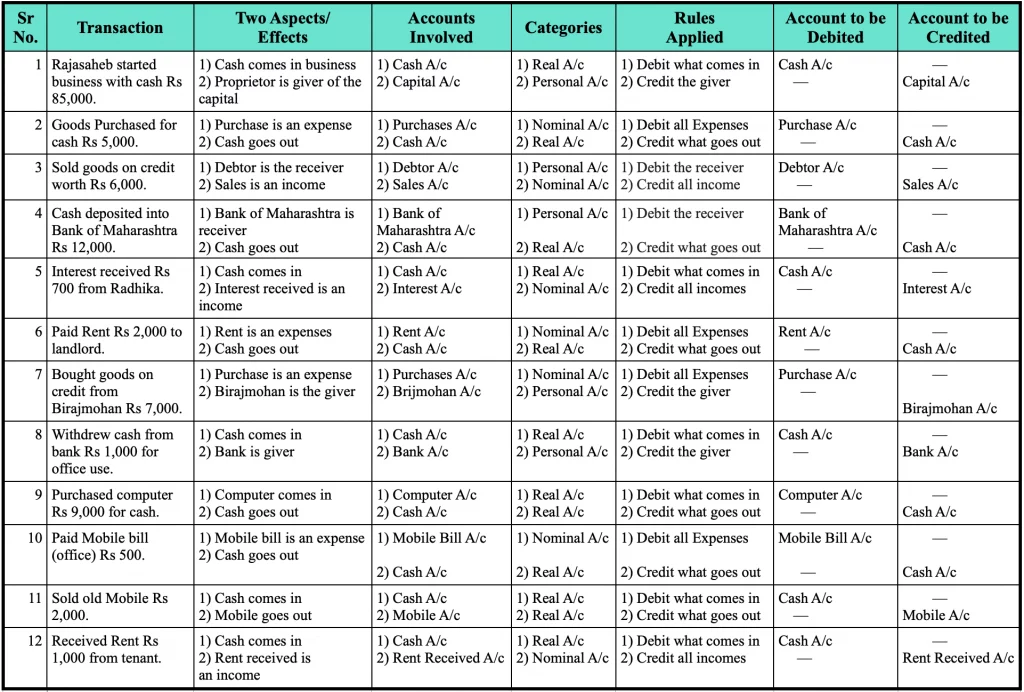
Q. 2 Prepare Chart showing Analysis of the following transaction in a Tabular form according to Modern Approach.
- Mr. Meghraj started business with cash Rs 30,000.
- Deposited cash into Bank of India Rs 2,000.
- Withdrew cash Rs 1,000 for personal use.
- Purchased goods on credit from Nilesh Rs 2,000.
- Cash purchases Rs 3,000.
- Paid Wages Rs 400.
- Purchase a chair for office use Rs 3.200.
- Sold goods to Mohan worth Rs 1,200.
- Withdrew Cash for Office use Rs 3,000.
- Sold old furniture Rs 9,000.
- Received Dividend of Rs 1,000.
- Paid for Printing bill book Rs 200.
Solution:
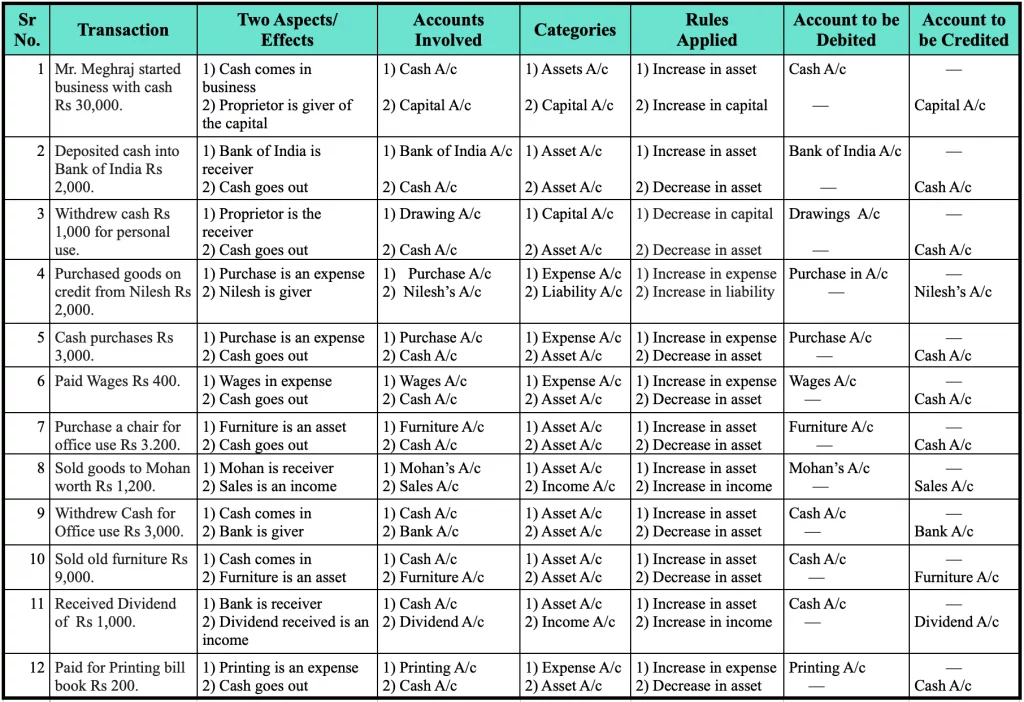
Q.3 Give the accounting equation for the following transactions.
- Mr. Vaibhav started business with Cash Rs 1,00,000.
- Purchased goods on credit from Rita Stores Rs 9,000.
- Purchase Laptop for office use Rs 10,000.
- Sold goods to Rina on credit Rs 12,000.
- Received Interest Rs 2,500
- Paid Telephone bill Rs 1,300.
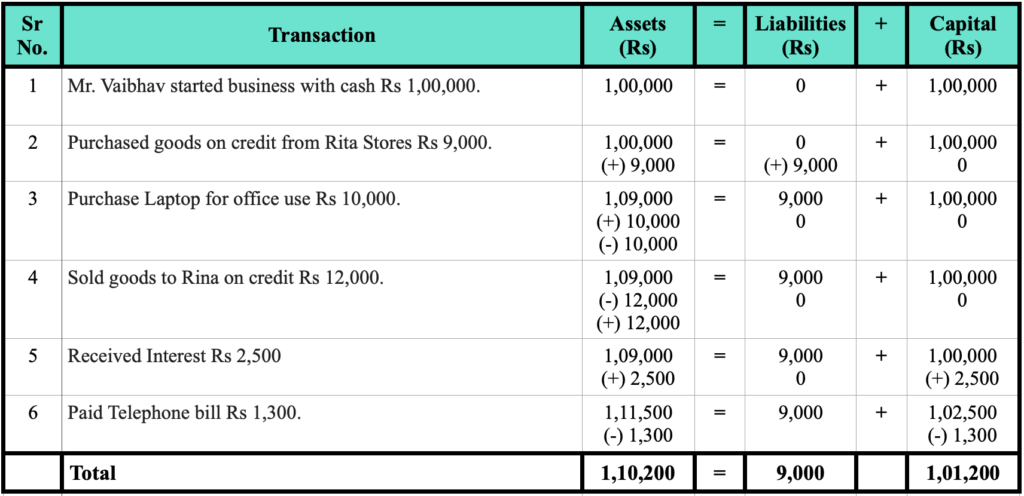
Q. 4 Give the accounting equation for the following transactions.
- Mr. Swaraj commenced business with Bank balance Rs 1,10,000.
- Purchased Furniture on credit from S.M Furniture Mart Rs 25,000.
- Bought goods on credit from Yuvraj Rs 15,000.
- Purchased Machinery Rs 10,000.
- Paid Electricity bill Rs 3,500.
- Goods destroyed by fire Rs 1,500.
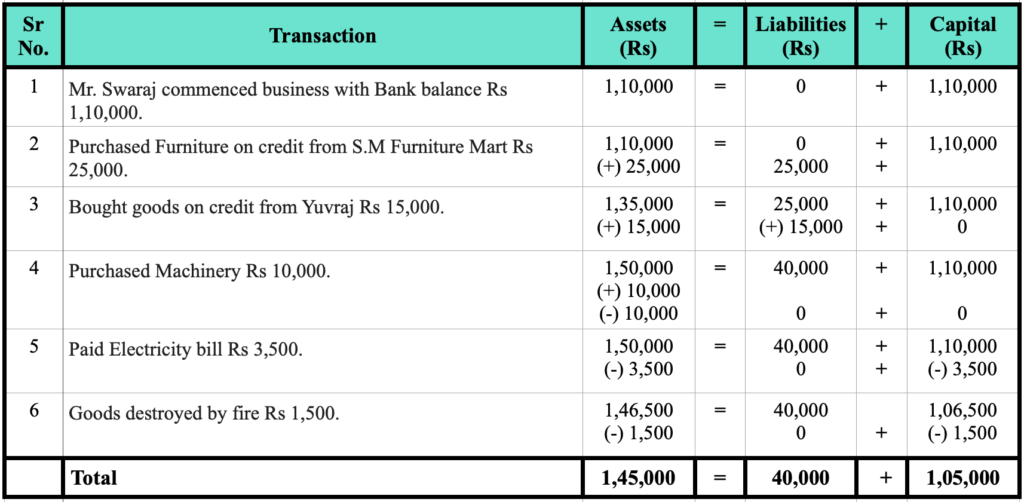
Q. 5 Show the accounting equation for the following transactions.
- Rohit started business with cash Rs 50,000.
- Bought goods on credit from Manoj Rs 6,000.
- Cash purchases Rs 5,000.
- Paid wages Rs 3,000 to Casual labour.
- Sold goods to Santosh Rs 7,000 on credit.
- Received Commission Rs 1,000 from Vaishali.
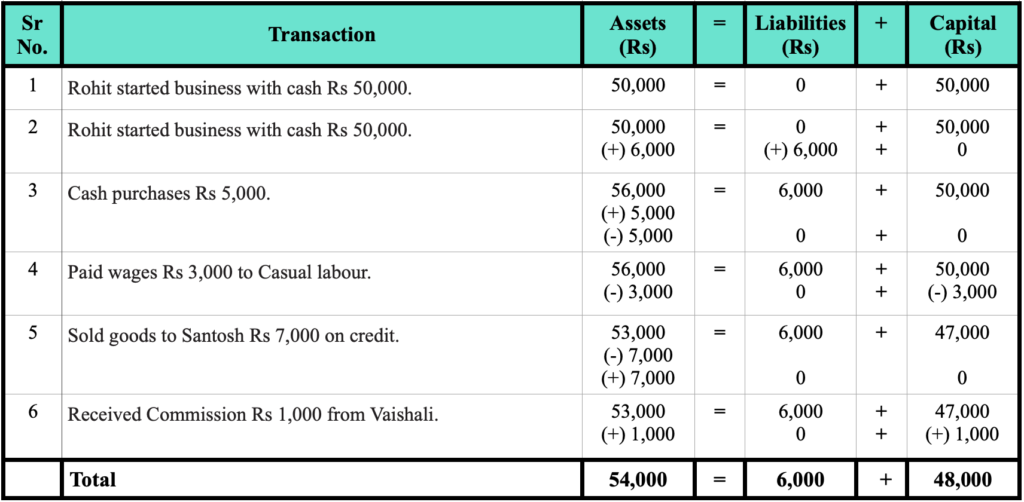
11th BK Chapter 2 Practical Problems
Solution of other subjects
Solution of all Chapters of BK
1 – 2 – 3 – 4 – 5 – 6 – 7 – 8 – 9 – 10
11th BK Textbook Solutions
| Chapter Name | Solution Link |
| 1) Introduction to Book-Keeping and Accountancy | Solution |
| 2) Meaning and Fundamentals of Double Entry Book-Keeping | Solution |
| 3) Journal | Solution |
| 4) Ledger | Solution |
| 5) Subsidiary Books | Solution |
| 6) Bank Reconciliation Statement | Solution |
| 7) Depreciation | Solution |
| 8) Rectification of Errors | Solution |
| 9) Final Accounts of a Proprietary Concern | Solution |
| 10) Single Entry System | Solution |
Check out other posts related to 11th Commerce
| Textbook Solutions of 11th Commerce (All Subjects) | Click Here |
| Free pdf of 11th Commerce Textbooks | Click Here |
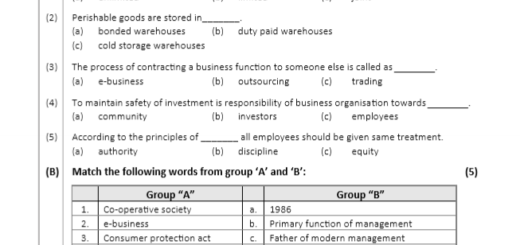
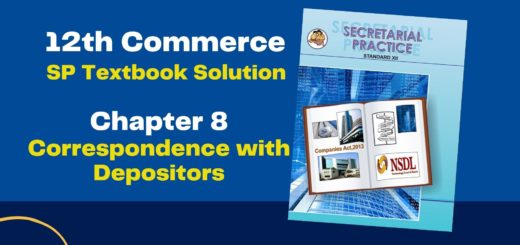
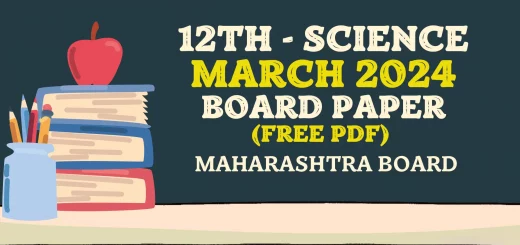
5 Responses
[…] Solution […]
[…] Solution […]
[…] of other subjectsSolution of all Chapters of IT 1 – 2 – 3 – […]
[…] Solution […]
[…] of other subjectsSolution of all Chapters of BK 1 – 2 – 3 – 4 – 5 – 6 – 7 – 8 – 9 – […]